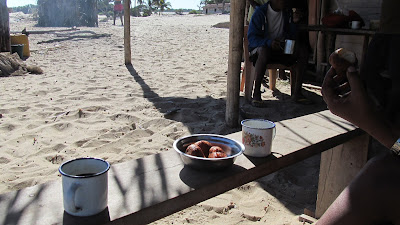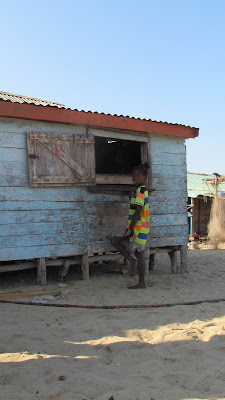 |
| Off to work! |
Mangroves occur in bays dotted all along the west coast of Madagascar, protecting thousands of hectares of shoreline that border the Mozambique Channel. Last month, Lalao and I conducted a needs assessment at another site in and around the town of Belo sur Mer, located about midway along the long edge of Madagascar. There are about 12 communities in the area; Blue Ventures is working with these to promote sustainable fisheries, develop alternative livelihoods and manage the mangrove forests. We visited 6 of these communities, and met with the village associations as the first step in developing our Blue Forests planning for the site.
The mangroves are extensive, largely intact and beautiful.
 |
Coffee and menakely for breakfast. Menakely (called boko boko in other places) is a lot like a donut, but not as sweet.
 |
| Accommodation in Belo sur Mer |
Left: Village meetings have to wait until the fishing day is done. And sometimes we get participation from the local chickens. This was our first meeting of the field tour, in Antananamibo.
Below: Eloi, the boat captain spotting a safe route for the pirogue in shallow water.
 |
Below: Coming back into Belo sur Mer, temporary shelters of migratory fishermen on a sandspit are backlit.


Left: Fran, a Blue Ventures aquaculture technician, checking out the drying seaweed. Local residents can make a decent living from seaweed farming. This is in the village of Menaky.
 |
| Typical, square-sailed pirogue used by fishermen all along the coast |
Women use a paste made from pounded bark as a sunscreen and beauty product.
 |
| Breakfast at the local cafe |
.....and then I was swarmed.
Meeting with the village association in Belalanda - the community members have a high level of interest in actively managing mangroves, well aware that the health of fisheries is heavily dependent on intact coastal mangrove forests.
Right: Lalanda, a dune-stabilizing plant with long runners.
Left: Men use handtools to carve wooden pirogues.

Two uses of mangrove wood.
Right: A woman is repairing her fence made of mangrove poles.
Above: Bags of charcoal, ready for transport and sale.



Another local coffee shop; the owner on the left is making menakely (basically fried cassava doughballs) on the right two of her children are pounding cassava into flour.
Below: The mangrove forest outside of Lovobe; some of the damage is from harvesting, but some of the mortality may have resulted from the effects of a cyclone that occurred 5 years ago, which may have changed tide levels along this part of the coast.
Left: The cyclone also destroyed the school in one village; the teacher holds classes outdoors.
Right: A convenience store sells packaged goods.
Below: Village women in Lovobe, the last stop on our field tour.

















